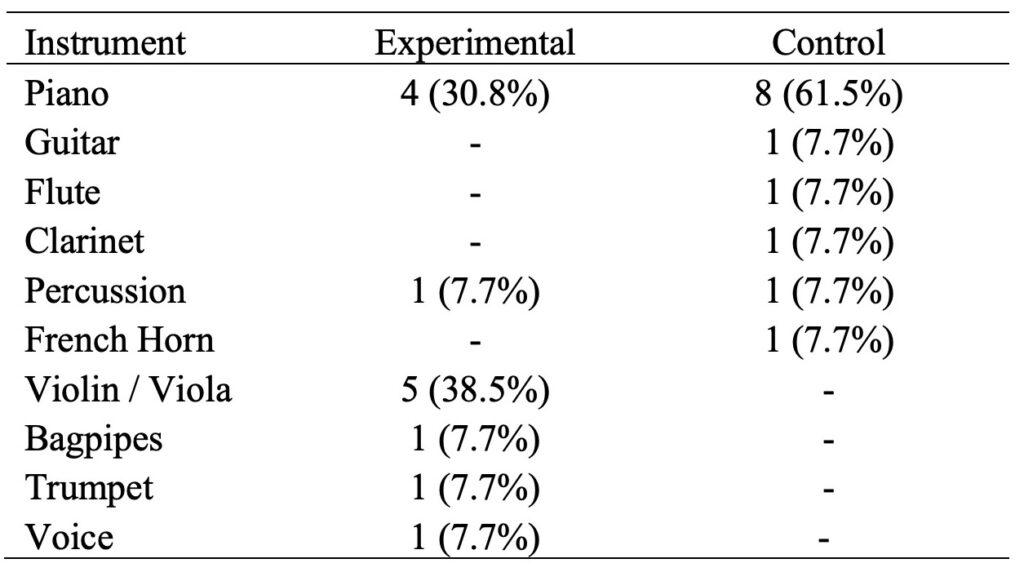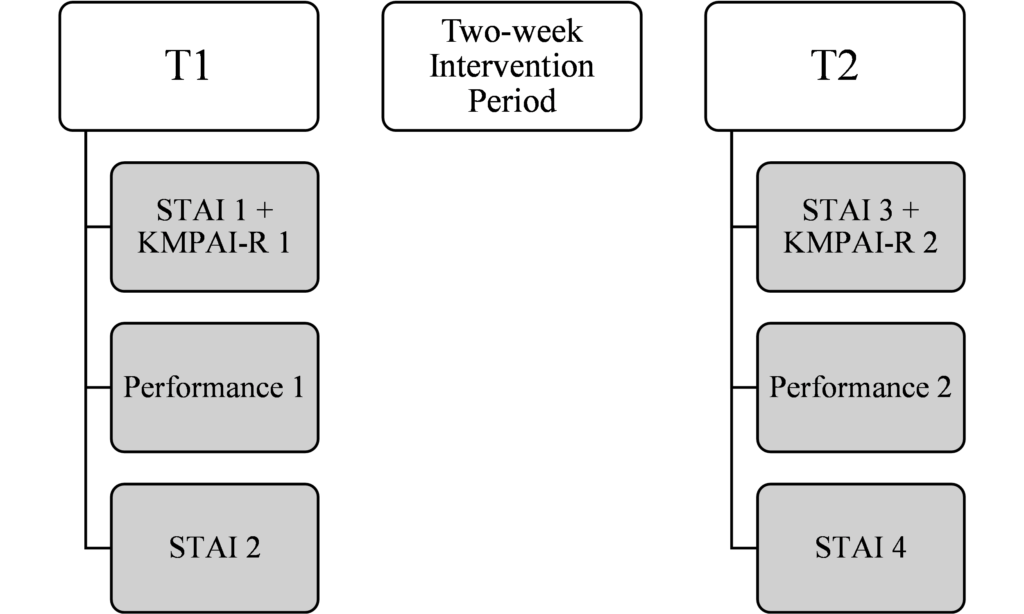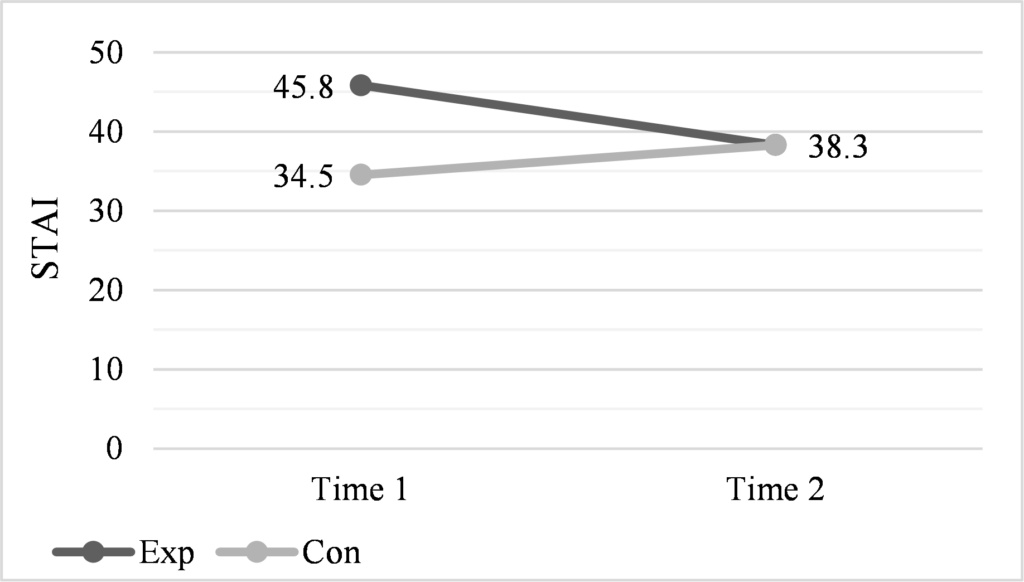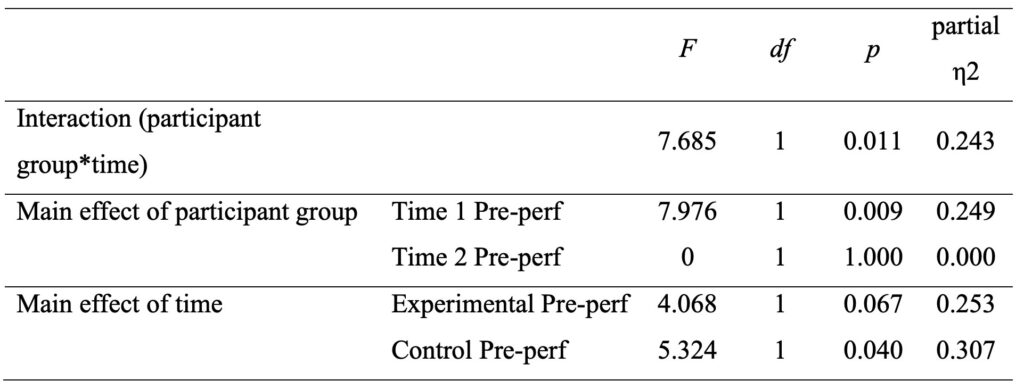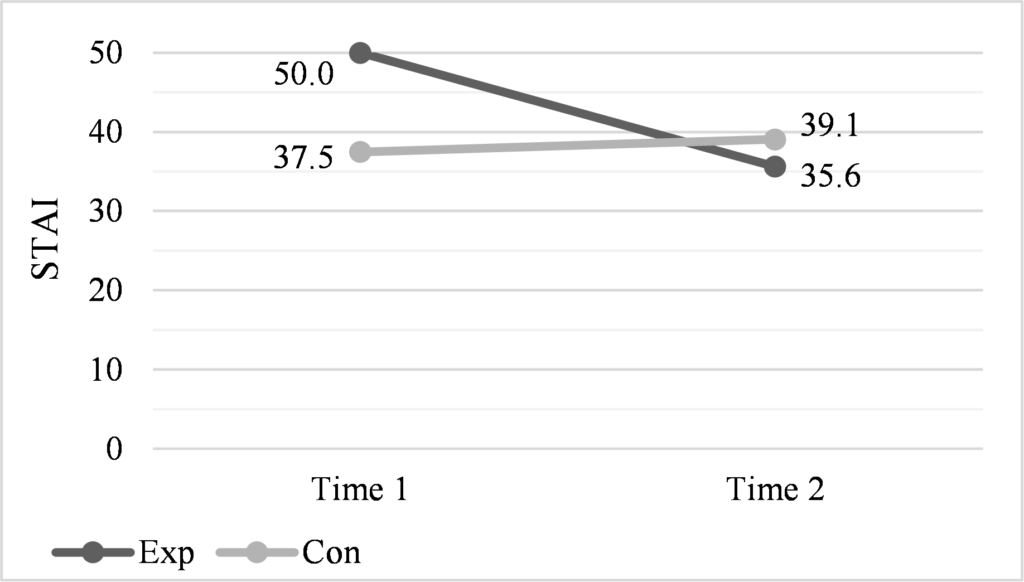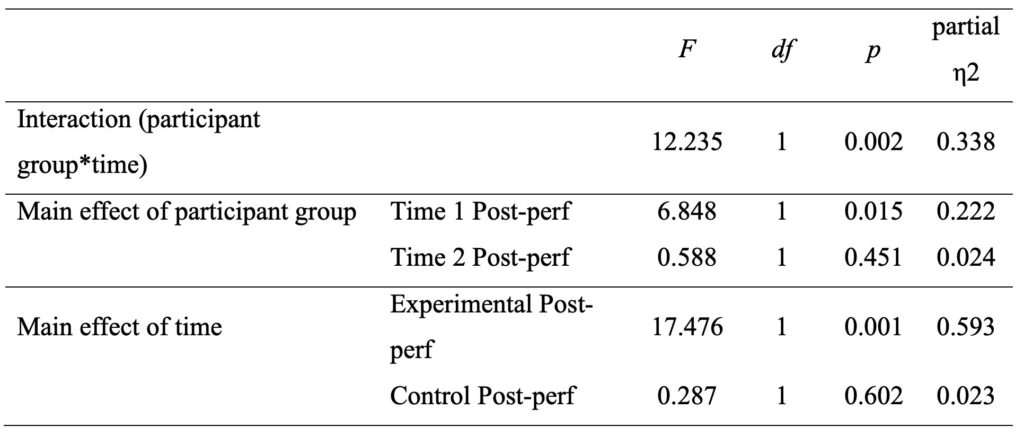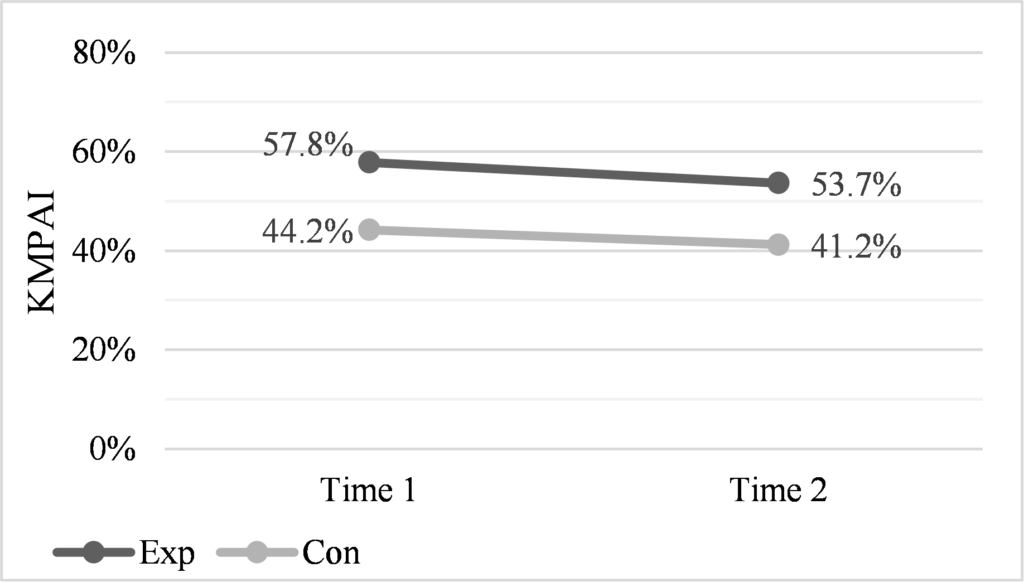The Effectiveness of Mindfulness Training on the Experience of Music Performance Anxiety in Young Adult Musicians. A Preliminary Investigation
Nicole Stanson, Gilles Comeau,
Andra Smith, and Mikael Swirp
| PDF | CITATION | AUTHORS |
Abstract
Research has shown that music performance anxiety (MPA) is experienced by individuals of all ages and skill levels. Due to the need for effective management of performance anxiety in musicians, researchers have begun to investigate the viability of mindfulness, which has been proven as an effective treatment in populations with generalized anxiety. This study assessed the effects of a two-week mindfulness intervention on musicians before and after a performance, using the State component of the State-Trait Anxiety Inventory (STAI) and the Revised Kenny Music Performance Anxiety Inventory (KMPAI-R). Results from this study suggest that mindfulness has a significantly positive effect on state anxiety in music performance, and that a two-week mindfulness training intervention model should be investigated further as a potential intervention to reduce MPA.
Keywords: anxiety; mindfulness; music; performance; questionnaire.
Résumé
La recherche a montré que l’anxiété liée aux performances musicales (APM) est ressentie par des individus de tous les groupes d’âge et de tous les niveaux de compétence. En raison de la nécessité d’une gestion efficace de l’anxiété de performance chez les musicien·ne·s, les chercheur·euse·s ont commencé à étudier la viabilité de la pleine conscience. Cette approche s’est avérée être un traitement efficace chez les populations souffrant d’anxiété généralisée. Notre étude a évalué les effets d’une intervention de pleine conscience de deux semaines sur des musicien·ne·s, avant et après une performance, en utilisant les mesures du State-Trait Anxiety Inventory (STAI) et le Revised Kenny Music Performance Anxiety Inventory (KMPAI-R). Les résultats de cette étude suggèrent que la pleine conscience a un effet positif significatif sur l’anxiété de la performance musicale, et qu’un modèle d’intervention de formation à la pleine conscience de deux semaines devrait être étudié plus avant comme une intervention potentielle pour réduire l’AMP.
Mots clés : anxiété ; musique ; performance ; pleine conscience ; questionnaire.
Introduction
Music performance anxiety (MPA) has been shown to impact adults, adolescents, and children alike, and Kenny has stated that “no category of performer is exempt from the experiences of MPA” (Kenny 2006, p. 56). Studies on musicians in professional orchestras have reported that most of this population struggles with their anxiety levels while performing. Johannes Van Kemenade and colleagues (1995) found that 59% of orchestral musicians experienced performance anxiety to such an extent that it impacted their personal and/or professional functioning. Similarly, Ian James (1998) surveyed 56 different orchestras and found that 70% of musicians experienced anxiety that interfered with their performance quality. The experience of performance anxiety is abundant throughout the Western classical music community, with music teachers and students alike voicing the need for better education on mechanisms for inhibiting the severity and debilitating nature of music performance anxiety (Fehm & Schmidt 2006; Sieger 2017). Furthermore, recent studies have suggested that age is a predictor for experiencing higher levels of MPA, with young musicians being disproportionately affected (Butković, Vukojević & Carević 2022). As outlined above, there is great need for effective management of MPA in the music performance community, and particularly in young musicians.
Research has demonstrated that mindfulness-based stress reduction (MBSR) can significantly reduce the symptoms of anxiety and depression (Astin 1997; Vøllestad, Siversten & Nielsen 2011; Hoge et al. 2013; Lo, Ng, & Chan 2014). The reduction of performance anxiety with the implementation of mindfulness interventions has also been documented in sports psychology research (Dehghani et al. 2018; Corbally, Wilkinson & Fothergill 2020; Sparks et al. 2021). Thus, it has been suggested that mindfulness could be beneficial for musicians (Chang, Midlarsky & Lin 2003; Diaz 2018; Kaleńska-Rodzaj 2021).
Mindfulness practices have also been researched as a potential coping mechanism for the reported 69% of university level music students experiencing performance anxiety (Khalsa & Cope 2006). This area of study began in 2003 with Joanne Chang, Elizabeth Midlarsky, and Peter Lin’s seminal research on the impacts of a meditation intervention on music students attending the Manhattan School of Music and has now been further explored by researchers looking at mindfulness training workshops and yoga. In 2006, Sat Bir Khalsa and Stephen Cope’s study on the impacts of yoga on MPA was published, becoming the first research article on the subject. In the work of both Chang and Khalsa, self-report questionnaires are used to collect the data for each study. The impacts of yoga on MPA have received the most research attention due to the interest of Khalsa and colleagues, while the relationship between mindfulness training and MPA is far less researched.
Many studies have demonstrated that mindfulness training can have positive effects on individuals struggling with generalized anxiety, and success with the application of mindfulness treatments on anxious musicians has also been observed (Chang, Midlarsky & Lin 2003; Lin et al. 2008; Vøllestad, Sivertsen & Nielsen 2011; Hoge et al. 2013; Lo, Ng & Chan 2014). Although there have been studies reporting positive effects of mindfulness training on MPA (Chang, Midlarsky & Lin 2003; Lin et al. 2008; Czajkowski & Greasley 2015; Czajkowski, Greasley & Allis 2022), the results of Laura Clevenger’s 2015 study contradict the concept of mindfulness mediating the symptoms of MPA. Moreover, the validity of certain results in this area of research (Clevenger 2015; Czajkowski & Greasley 2015; Czajkowski, Greasley & Allis 2022) must be viewed critically, since the reliability of self-report questionnaires to measure a participant’s level of mindfulness has been questioned (Van Dam, Earleywine & Danoff-Burg 2009; Grossman & Van Dam 2011; Van Dam et al. 2012; Van Dam et al. 2014; Van Dam et al. 2018), and most intervention studies on MPA and mindfulness thus far have not employed control group study designs (Chang, Midlarsky & Lin 2003; Czajkowski & Greasley 2015; Czajkowski, Greasley & Allis 2022). It must therefore be concluded that additional experimentation on the effects of mindfulness training on MPA should be undertaken to corroborate the effectiveness of this intervention.
The aim of this study was to expand the literature on mindfulness interventions for MPA in the context of young adult musicians with the addition of employing a control group study design. Additionally, this study utilized a two-week mindfulness intervention to examine the effectiveness of a condensed treatment period.
Methodology
Participants
Participants in this study were experienced young adult musicians with completed or nearly completed undergraduate or graduate degrees in music, or a minimum of grade 7 from the Royal Conservatory of Music. Participants were excluded from participating if they had engaged in an established practice of mindfulness activities and/or mindfulness training prior to the onset of the study, or were being treated for a current psychological disorder.
A power calculation was completed to determine the required sample size. Acknowledging that this would be a small-scale study we expected to detect a medium or large effect. Additionally, several other studies have found medium or large effects of mindfulness interventions on anxiety levels (Chang, Midlarsky & Lin 2003; Hoge et al. 2013; Lo, Ng & Chan 2014; Vøllestad, Silvertsen & Nielsen 2011). For a 2-sided test, with a power of 0.80 and alpha of 0.05, a total of 16 participants are required for a large effect or 34 participants for a medium effect, thus we recruited 26 participants to be within that range. The first 13 participants who registered to be a part of this study were allocated to the experimental group, while the next 13 served as the control group. The experimental group consisted of 7 females and 6 males ranging from age 20 to 35 (mean age = 25.2 years). The control group had the same ratio of females to males with an age range of 18-28 (mean age = 23.1 years). Table 1 shows the breakdown of instruments played by each group.
Table 1: Number and percentage (in parenthesis) of participants who play each given instrument.
Participants were recruited through convenience sampling by email invitation, and passive recruitment by wall mounted posters throughout the University of Ottawa music building. Additionally, private music instructors were asked to distribute the study information to their students. This was a typical case sampling with the intention of attracting a group that reflects the overall experience of music performance anxiety in the young adult music performance sector of Ottawa. This study was approved by the University of Ottawa Research Ethics Board and individuals read the letter of information indicating what participation in the study entailed and signed a consent form prior to any research activities taking place. Once the consent form was signed participants were asked to fill out a demographic questionnaire. Information included age, gender, previous experience with mindfulness activities (yoga, meditation, mindfulness-based stress reduction), use of alcohol and beta blockers, cardiovascular health, and pre-existing psychological conditions. Participants were then given a full overview of the intervention structure, and how the data collection sessions would progress.
Data Collection. Questionnaires
Anxiety was measured directly before and after a staged performance (details below) using the State section of the State-Trait Anxiety Inventory (STAI) (Spielberger 1989) and the Revised Kenny Music Performance Anxiety (KMPAI-R). These measures were chosen due to their ubiquity in the literature.
1. Spielberger State-Trait Anxiety Inventory
This questionnaire contains 20 questions in which participants use a four-point Likert scale to rate their response. Participants are asked to respond with how much each statement resonates with how they feel at this moment, and the option of responses range from “not at all” to “very much so.” Each question is phrased as a first-person statement and pertains to both anxiety positive and anxiety negative states. For example, question two states “I feel secure,” and question four states “I feel strained.”
2. Revised Kenny Music Performance Anxiety Inventory (KMPAI-R)
The KMPAI-R is a 40-item questionnaire measuring MPA through 7 subsections: proximal somatic anxiety and worry about performance, worry/dread (negative cognitions) focused on self/other scrutiny, depression/hopelessness (psychological vulnerability), parental empathy, memory, generational transmission of anxiety, anxious apprehension, and biological vulnerability. Items on the KMPAI-R are phrased as first-person statements, and participants are asked to rate their level of agreeance with each question on a scale of 0-6. A higher score on this measure indicates higher levels of MPA.
Procedure
1. Testing Sessions
The study was performed with a longitudinal design, testing participants twice, using identical protocols for Time 1 and Time 2. Each participant was asked to arrive ten minutes prior to their scheduled appointment. They were asked to bring their instrument as they would be performing a piece in front of a jury. They were each asked to prepare roughly 10 minutes of repertoire that they had performed at least once previously. Upon arrival, participants were brought to a quiet and private space where they received an overview of how the session would progress, then filled out the KMPAI-R and state questions of the STAI (STAI 1 and 3). After completing the questionnaires, the participant was given approximately 5-7 minutes to warm up on their instrument before being brought to a different room and performing 6-10 minutes of solo repertoire in front of a mock jury panel of two individuals. The role of the jury was to invoke the experience of a real audition/performance situation. Participants were told the jury was there to evaluate their performance. The room was temperature controlled, and had light cancelling curtains which controlled the potential effect of outdoor distractions or influences. Directly after the performance, the participant was guided back to the same private space in which they completed the state questions of the STAI a second time to quantify state anxiety following the performance (STAI 2 and 4).
2. Mindfulness Intervention
The experimental group then underwent a two-week mindfulness training program, while the control group was not involved in any activity provided by the research team. Additionally, the control group was not permitted to participate in any mindfulness-type activities while they were a part of the study including meditation, yoga, and mindfulness workshops or stress relief courses. The program was comprised of ten sessions over the course of two weeks, and consisted of meditation, breath awareness, body scanning, mindful walking, qigong, and discussion groups. During the discussion, participants were encouraged to talk about their experience with the mindfulness training so far, their daily stresses, and their experience with MPA in the past. Often, the teacher would call upon each individual to share some aspect of their experience so that each person was contributing to the discussion.
The first week of mindfulness training took place from Monday to Friday, with Saturday and Sunday serving as days off from the practice. Another five mindfulness training sessions took place from Monday to Friday of the second week, and the Time 2 data collection took place on the Saturday or Sunday directly after the conclusion of mindfulness training. Each session ran from 8:30 to 9:30 a.m. and was conducted in a group format. A total of ten mindfulness classes were offered over the course of the two-week intervention. In attempt to control the amount of exposure to mindfulness practice each participant was subject to during the experiment, participants were asked to come to a minimum of six and a maximum of nine sessions and to refrain throughout the duration of the intervention from any practice of additional mindfulness activities (meditation, yoga, mindfulness-based stress reduction, etc.) outside of the formal sessions.
The mindfulness classes were designed and taught by a registered speech language pathologist and facilitator in Mindfulness Based Cognitive Therapy (MBCT) and Mindfulness Based Stressed Reduction (MBST).
At the end of the two-week intervention period, all participants took part in Time 2 data collection identical in structure to the Time 1 session. See Figure 1 below for further clarification of the structure utilized for this study.
Figure 1: Structure of the experiment.
Analysis. Questionnaires
Data analysis was performed using the Statistical Package for Social Sciences (SPSS), version 25. The data set was checked for outliers (a z-score of more than 2.58 was considered an outlier) and normality (using the Shapiro-Wilk test). No outliers were found, and the results were normally distributed. First, we examined STAI results from directly before the performance at Time 1 and Time 2 to determine if there was a change in anxiety levels in anticipation of performing. We used a 2-way mixed model using time as the within-subjects factor, and experiment group as the between-subjects factor to determine if the experiment group exhibited a greater change in STAI scores from Time 1 to Time 2. Next, the same test process was used for the STAI scores from directly after the performance. Finally, the same test process was used for the KMPAI-R scores, although only one test was required because the KMPAI-R questionnaire was only administered before the performance.
Results
Pre-Performance STAI
To investigate if the change in pre-performance STAI scores from Time 1 to Time 2 was different for the experimental group versus the control group, a two-way mixed ANOVA was used. See Figure 2 for the change in mean STAI scores from Time 1 to Time 2, and Table 2 for the statistical results.
Figure 2: Change in pre-performance STAI from Time 1 to Time 2 for experimental and control groups.
Table 2: Results of two-way mixed ANOVA comparing the change in pre-performance STAI scores between Time 1 and Time 2.
In the pre-performance category, the experimental group STAI scores reduced, while the STAI scores of the control group increased. This difference in the change in anxiety was statistically significant (p = 0.011). It was also found that there was a significant difference in the Time 1 anxiety levels between the two groups (p = 0.009). At post-intervention, the mean STAI scores were the same (38.3 for both groups). The mean STAI scores of both groups changed from Time 1 to Time 2. The controls increased significantly (p = 0.040). The experimental group exhibited a reduction that was almost significant (p = 0.067), with a large effect size, using the partial η2 benchmarks suggested by Cohen (Cohen 1988, p. 287).
Figure 3: Change in after-performance STAI from Time 1 to Time 2 for experimental and control groups.
Post-performance STAI
A two-way mixed ANOVA was also used to investigate if the change in post-performance STAI scores from Time 1 to Time 2 was different for the experimental group verses the control group. See Figure 3 for the change in mean STAI scores from Time 1 to Time 2, and Table 3 for the statistical results.
Table 3: Results of two-way mixed ANOVA comparing the change in post-performance STAI scores between Time 1 and Time 2.
In the post-performance category the experimental group scores decreased while the control group scores increased. This difference in change of anxiety was statistically significant (p = 0.002). Once again when the main effect of group was analyzed, it was found that there was a significant difference between groups at Time 1 (p = 0.015). It was also found that the two groups were not statistically different in the post-intervention condition (p = 0.451). Both groups mean STAI scores changed from Time 1 to Time 2. The control group mean increased, but not significantly (p = 0.602). The experimental group exhibited a significant reduction in anxiety from pre- to post-intervention (p = 0.001), with a large effect size.
KMPAI
A two-way mixed ANOVA was used to investigate if the change in KMPAI scores from Time 1 to Time 2 was different for the experimental group verses the control group. See Figure 4 for the change in mean KMPAI scores from Time 1 to Time 2.
There was no statistically significant interaction between the experimental group and time on STAI scores, F(1, 24) = 0.036, p = 0.850, partial η2 = 0.180 (i.e., the change in scores from Time 1 to Time 2 was not significantly different between groups). The main effect of group showed that there was a statistically significant difference in KMPAI scores between groups, F(1, 24) = 5.27, p = 0.002, partial η2 = 0.348. Similarly, the main effect of time showed a statistically significant difference in scores at the different time points, F(1, 24) = 5.27, p = 0.031, partial η2 = 0.18.
Figure 4: Change in KMPAI scores from Time 1 to Time 2 for experimental and control groups.
Discussion
This exploratory study examined the impact of a 2-week mindfulness training program on MPA in young adult musicians. The intent was to investigate the impact of this short intervention on state anxiety prior to and just after a musical performance. To interpret the results, pre- and post-performance testing will be considered separately.
Pre-Performance STAI Results (STAI 1 and 3)
Results from the pre-performance category indicated that the experimental group experienced an almost-significant reduction in anxiety from Time 1 to Time 2, while the control group experienced a significant increase in anxiety from pre-intervention to post-intervention. However, the results also indicated that the groups experienced significantly different levels of anxiety during the Time 1 data collection, indicating that these groups may be demographically different. This difference in Time 1 anxiety levels could be attributed to the method used to recruit participants. For this study participants were recruited for the experimental group first using advertising that emphasized the opportunity to experience mindfulness classes that may aid in anxiety reduction. The control group was then recruited over the course of a few months following the mindfulness classes. Since the mindfulness classes could no longer be offered, the study was no longer being advertised with the offer of mindfulness training as a central benefit. This method of recruiting was chosen due to the time restrictions imposed by booking the mindfulness practitioner, and therefore, to maximize group size all participants recruited were allocated to the mindfulness group. It can therefore be surmised that anxious individuals with a vested interest in mindfulness as a coping tool were allocated to the experimental group, while less anxious individuals that did not have this interest were allocated to the control group. If the results are considered from this perspective, the anxiety level of the highly-anxious experimental group reduced to the level of the mildly-anxious control group between Time 1 and Time 2. The results can be interpreted to indicate that mindfulness engendered a reduction of anxiety in the experimental group prior to performance. One of the central elements of mindfulness training is to increase focus on the present moment. It may be that the mindfulness sessions enhanced the participants’ ability to stay present, thus limiting preoccupation with the past and future, resulting in decreases in anticipatory performance anxiety. Additionally, the mindfulness training may have prevented the experimental group from exhibiting an increase in anxiety similar to that of the control group, whose anxiety rose a statistically significant amount between Time 1 and Time 2.
Post-performance STAI Results (STAI 2 and 4)
Results from the post-performance category indicated that the experimental group experienced a significant decrease in anxiety from Time 1 to Time 2, while the control group experienced a non-significant increase in anxiety from Time 1 to Time 2. Once again, results indicated that the experimental group and control group exhibited significantly different levels of anxiety in the pre-intervention session. A similar interpretation can be made regarding demographic differences between groups as was proposed in the previous section: considering the recruitment process, we may be observing the high-anxiety experimental group decreasing significantly to meet the levels of a low-anxiety control. Nevertheless, the results can be interpreted to indicate that the mindfulness training led to a significant decrease of anxiety in the experimental group after performance. Often after a performance, musicians experience ruminations and self-critical thoughts about their performance. Perhaps mindfulness reduced this self-deprecation, allowing the musicians to move on non-judgmentally.
KMPAI-R Results
Both groups exhibited a significant decrease in score on this measurement between Time 1 and Time 2, however, these results may not be considered reliable. The KMPAI-R measures well-established feelings that have been generated over a long duration, for example: “as a child I often felt sad”, “one or both of my parents were overly anxious,” etc. These factors would not be expected to change much, if at all, over a two-week intervention period. This measure would have been better suited as an intake questionnaire to ensure that participants were within a certain range of anxiousness, as opposed to a comparison between Time 1 and Time 2.
General Discussion
The results from this study suggest that participating in a mindfulness training intervention resulted in a significant reduction in anxiety prior to and following a performance. This result is in line with previous research demonstrating that mindfulness training can reduce anxiety in clinical populations with generalized anxiety symptoms. A limited number of studies have been conducted pertaining to the relationship between mindfulness and the experience of MPA, but this study provides compelling evidence for further research into this field of inquiry.
An important contribution of the current study is the validation of a two-week mindfulness training intervention. Previous studies in this field have utilized an eight-week model in which participants underwent one mindfulness session per week (Hoge et al. 2013; Lo, Ng & Chan 2014; Vøllestad, Silvertsen & Nielsen 2011; Czajkowski & Greasley 2015; Czajkowski, Greasley & Allis 2022), whereas the current study used a condensed two-week model with six to nine sessions. Despite the difference of intervention length, this study succeeded in producing results similar to the aforementioned studies, while providing results that substantiate the two-week model as a viable option for future mindfulness intervention research. The use of the two-week mindfulness training model could be beneficial in designing research with demographic populations for which prolonged participation is not possible, and therefore replication of this intervention is recommended with a larger sample size and randomized control.
Limitations
Although the results of this preliminary study indicate the viability of future research, some limitations should be addressed. The primary limitation of this study was sample size. Further research with a larger sample size is recommended to support the results produced in this article. Additionally, this study did not employ a randomized control trial design and could have benefited from a more homogenous sampling between control and experimental groups. Future research in this area should undertake randomized control trial testing to ensure similar levels of baseline MPA in both the control and experimental groups.
Conclusion
Music performance anxiety impacts the lives of many musicians who could benefit from constructive coping mechanisms to minimize the intensity of their symptoms. This study examined the effect of a mindfulness training intervention on young musicians, and results indicated that the training can significantly decrease self-reported MPA both before and after a performance. Further research would have to be pursued to identify if this was a clinically significant effect. Additionally, results of this study indicated that a condensed two-week mindfulness training intervention model can engender anxiety reductions previously observed using an eight-week model.
Bibliography1All hyperlinks checked 30 October 2022.
Astin, John (1997), “Stress Reduction through Mindfulness Meditation,” Psychotherapy and psychosomatics, vol. 66, no 2, pp. 97–106, https://doi.org/10.1159/000289116.
Butković, Ana, Nikolina Vukojević, and Sara Carević (2022), “Music Performance Anxiety and Perfectionism in Croatian Musicians,” Psychology of Music, vol. 50, no 1, pp. 100–110, https://doi.org/10.1177/0305735620978692.
Chang, Joanne, Elizabeth Midlarsky, and Peter Lin (2003), “Effects of Meditation on Music Performance Anxiety,” Medical Problems of Performing Artists, vol. 18, no 3, pp. 126–131, https://doi.org/10.21091/mppa.2003.3022.
Clevenger, Laura (2015), A Study of the Correlation Between Mindfulness and Music Performance Anxiety Among College Music Majors. Implications for Counseling and Counselor Education, Ph.D. diss., Capella University, www.proquest.com/docview/1756672496?pq-origsite=gscholar&fromopenview=true.
Cohen, Jacob ([1977]1988), Statistical Power Analysis for the Behavioral Sciences, 2nd ed., Mahwah, Lawrence Erlbaum Associates, www.utstat.toronto.edu/~brunner/oldclass/378f16/readings/CohenPower.pdf.
Corbally, Linda, Mick Wilkinson, and Melissa Fothergil (2020), “Effects of Mindfulness Practice on Performance and Factors Related to Performance in Long-Distance Running. A Systematic Review,” Journal of Clinical Sport Psychology, vol. 14, no 4, pp. 376–398, https://doi.org/10.1123/jcsp.2019-0034.
Czajkowski, Anne-Marie L., and Alinka E. Greasley (2015), “Mindfulness for Singers. The Effects of a Targeted Mindfulness Course on Learning Vocal Technique,” British Journal of Music Education, vol. 32, no 2, pp. 211–233, https://doi.org/10.1017/S0265051715000145.
Czajkowski, Anne-Marie L., Alinka E. Greasley, and Michael Allis (2022), “Mindfulness for Musicians. A Mixed Methods Study Investigating the Effects of 8-Week Mindfulness Courses on Music Students at A Leading Conservatoire,” Musicae Scientiae, vol. 26, no 2, pp. 259–279, https://doi.org/10.1177/1029864920941570.
Dehghani, Mahmood, et al. (2018), “Effectiveness of the Mindfulness-Acceptance-Commitment-Based Approach on Athletic Performance and Sports Competition Anxiety. A Randomized Clinical Trial,” Electronic physician, vol. 10, no 5, pp. 6749–6755, https://doi.org/10.19082/6749.
Diaz, Frank (2018), “Relationships Among Meditation, Perfectionism, Mindfulness, and Performance Anxiety Among Collegiate Music Students,” Journal of Research in Music Education, vol. 66, no 2. pp. 150–167, https://doi.org/10.1177/0022429418765447.
Fehm, Lydia, and Katja Schmidt (2006), “Performance Anxiety in Gifted Adolescent Musicians,” Anxiety Disorders, vol. 20, no 1, pp. 98–109, https://doi.org/10.1016/j.janxdis.2004.11.011.
Grossman, Paul, and Nicholas Van Dam (2011), “Mindfulness, by Any Other Name… Trials and Tribulations of Sati in Western Psychology and Science,” Contemporary Buddhism, vol. 12, no 1, pp. 219–239, https://doi.org/10.1080/14639947.2011.564841.
Hoge, Elizabeth A., et al. (2013), “Randomized Controlled Trial of Mindfulness Meditation for Generalized Anxiety Disorder. Effects on Anxiety and Stress Reactivity,” The Journal of Clinical Psychiatry, vol. 74, no 8, pp. 786–792, https://doi.org/10.4088/JCP.12m08083.
James, Ian (1998), “Western Orchestral Musicians are Highly Stressed,” Resonance. International Music Council, vol. 26, pp. 19–20.
Kaleńska-Rodzaj, Julia (2021), “Music Performance Anxiety and Pre-performance Emotions in the Light of Psychology of Emotion and Emotion Regulation,” Psychology of Music, vol. 49, no 6, pp. 1758–1774, https://doi.org/10.1177/0305735620961154.
Kenny, Dianna (2006), “Music Performance Anxiety. Origins, Phenomenology, Assessment and Treatment,” Context, vol. 31, pp. 51–64, https://search.informit.org/doi/10.3316/informit.321654703853337.
Khalsa, Sat Bir, and Stephen Cope (2006), “Effects of a Yoga Lifestyle Intervention on Performance Related Characteristics of Musicians. A Preliminary Study,” Medical Science Monitor, vol. 12, no 8, pp. CR325–CR331, https://europepmc.org/article/med/16865063.
Lin, Peter, et al. (2008), “Silent Illumination. A Study on Chan (Zen) Meditation, Anxiety, and Musical Performance Quality,” Psychology of Music, vol. 36, no 2, pp. 139–155, https://doi.org/10.1177/0305735607080840.
Lo, Herman, Siu Ng, and Cecilia Chan (2014), “Evaluating Compassion-Mindfulness Therapy for Recurrent Anxiety and Depression. A Randomized Control Trial,” Research on Social Work Practice, vol. 25, no 6, pp. 715–725, https://doi.org/10.1177/1049731514537686.
Sieger, Crystal (2017), “Music Performance Anxiety in Instrumental Music Students. A Multiple Case Study of Teacher Perspectives,” Contributions to Music Education, vol. 42, pp. 35–52, www.jstor.org/stable/26367435.
Sparks, Katherine, et al. (2021). “Mindfulness, Reinvestment, and Rowing under Pressure. Evidence for Moderated Moderation of the Anxiety-Performance Relationship,” Psychology of Sport and Exercise, vol. 56, no 101998, https://doi.org/10.1016/j.psychsport.2021.101998.
Spielberger, Charles D. (1989), State-Trait Anxiety Inventory. A Comprehensive Bibliography, 2nd ed., Palo Alto, Consulting Psychologists Press.
Van Dam, Nicholas, et al. (2012), “Mind Your Words. Positive and Negative Items Create Method Effects on the Five Facet Mindfulness Questionnaire,” Assessment, vol. 19, no 2, pp. 198–204, https://doi.org/10.1177/1073191112438743.
Van Dam, Nicholas, et al. (2014), “How does Mindfulness Reduce Anxiety, Depression, and Stress? An Exploratory Examination of Change Processes in Wait-List Controlled Mindfulness Meditation Training,” Mindfulness, vol. 5, no 5, pp. 574–588, https://doi.org/10.1007/s12671-013-0229-3.
Van Dam, Nicholas, et al. (2018), “Mind the Hype. A Critical Evaluation and Prescriptive Agenda for Research on Mindfulness and Meditation,” Perspectives on Psychological Science, vol. 13, no 1, pp. 36–61, https://doi.org/10.1177/1745691617709589.
Van Dam, Nicholas, Mitch Earleywine, and Sharon Danoff-Burg (2009), “Differential Item Function Across Meditators and Non-Meditators on the Five Facet Mindfulness Questionnaire,” Personality and Individual Differences, vol. 47, no 5, pp. 516–521, https://doi.org/10.1016/j.paid.2009.05.005.
Van Kemenade, Johannes, Maarten Van Son, and Nicolette Van Heesch (1995), “Performance Anxiety Among Professional Musicians in Symphonic Orchestras. A Self-Report Study,” Psychological Reports, vol. 77, no 2, pp. 555–562, https://doi.org/10.2466/pr0.1995.77.2.555.
Vøllestad, Jon, Børge Sivertsen, and Geir Nielsen (2011), “Mindfulness-based Stress Reduction for Patients With Anxiety Disorders. Evaluation in a Randomized Control Trial,” Behavior Research and Therapy, vol. 49, no 4, pp. 281–288, https://doi.org/10.1016/j.brat.2011.01.007.
| RMO_vol.9.2_Stanson_et_al |
Attention : le logiciel Aperçu (preview) ne permet pas la lecture des fichiers sonores intégrés dans les fichiers pdf.
Citation
- Référence papier (pdf)
Nicole Stanson, et al., « The Effectiveness of Mindfulness Training on the Experience of Music Performance Anxiety in Young Adult Musicians. A Preliminary Investigation », Revue musicale OICRM, vol. 9, no 2, 2022, p. 102-115.
- Référence électronique
Nicole Stanson, et al., « The Effectiveness of Mindfulness Training on the Experience of Music Performance Anxiety in Young Adult Musicians. A Preliminary Investigation », Revue musicale OICRM, vol. 9, no 2, 2022, mis en ligne le 27 décembre 2022, https://revuemusicaleoicrm.org/rmo-vol9-n2/the-effectiveness-of-mindfulness-training/, consulté le…
Authors
Nicole Stanson, University of Ottawa
Nicole Stanson is a classically trained trumpetist with a passion for research in the cross-sectional domain of music and health. Having received degrees in both music performance as well as music pedagogy research, Nicole brings a unique perspective to the field of music and health. Nicole now works at the Music and Health Research Institute at the university of Ottawa where she assists the team with research, outreach, and education projects.
Gilles Comeau, Music and Health Research Institute, School of Music at the University of Ottawa
Gilles Comeau is a Fellow of the Royal Society of Canada, the founding director of the Music and Health Research Institute, the founding director of the Musicians’ Wellness Centre, the director and principal researcher of the Piano Pedagogy Research Laboratory, and a professor at the School of Music at the University of Ottawa. He has been the beneficiary of many research grants and his research laboratory conduct multidisciplinary research on various aspects of music learning, performing and teaching including: piano-playing health injuries, physical aspect of instrumental playing, motivation, music reading, video-mediated learning, music and health, music and wellbeing. His research findings have received coverage in various academic journals as well as in popular media outlets (television and magazine).
Andra Smith, University of Ottawa
Andra Smith is a Full Professor in the School of Psychology at the University of Ottawa. She is a neuroscientist with a background in brain imaging and understanding the neural benefits of mindfulness interventions.
Mikael Swirp, University of Ottawa
Mikael Swirp has a background in mechanical engineering as well as piano teaching and performance. He is currently the research Associate at the University of Ottawa Piano Pedagogy Research Laboratory where he has supported and mentored many graduate students throughout their studies and research. He has contributed to studies covering many aspects of music pedagogy including motivation, hearing sensitivity, musician health and music reading. He has co-authored several articles on these subjects.
Notes
| ↵1 | All hyperlinks checked 30 October 2022. |
|---|

